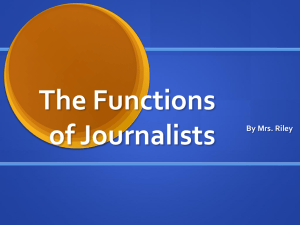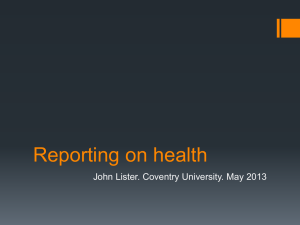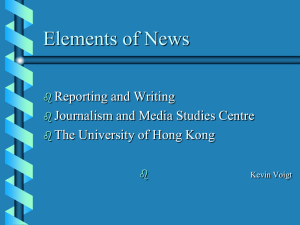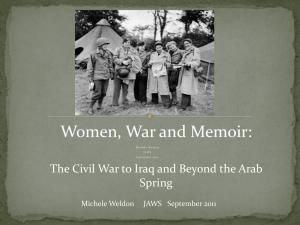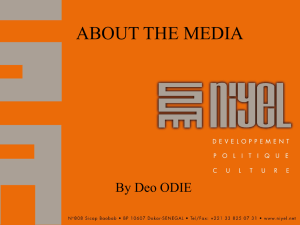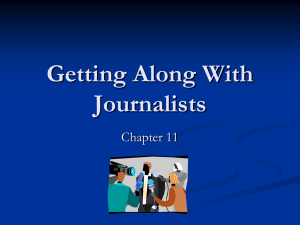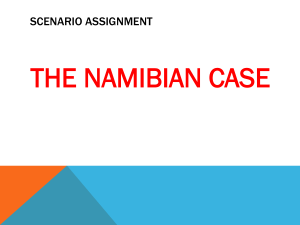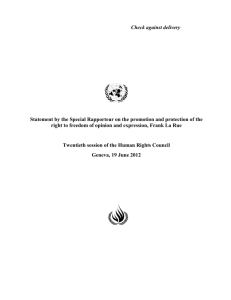MEDIA FREEDOM, RIGHTS AND RESPONSIBILITIES
advertisement
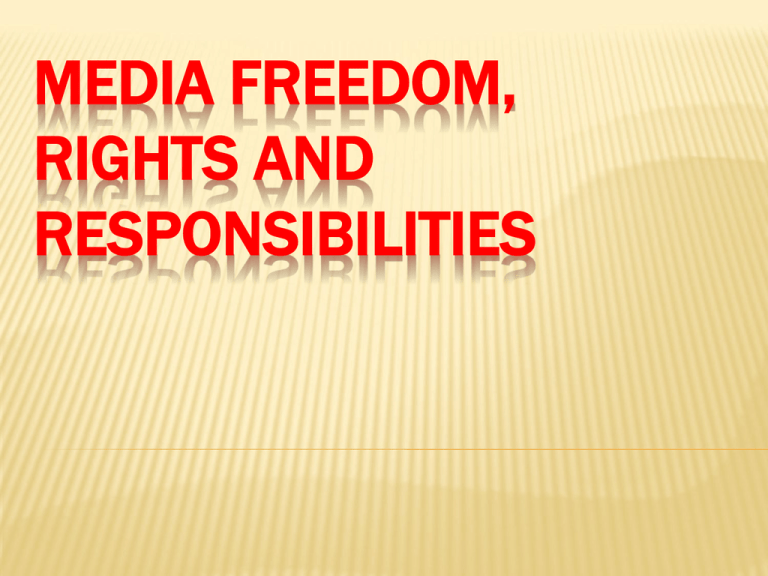
MEDIA FREEDOM, RIGHTS AND RESPONSIBILITIES International Conventions Article 19 of the Universal Declaration of Human Rights Everyone has the right to freedom of opinion and expression; this right includes freedom to hold opinions without interference and to seek, receive and impart information and ideas through any media and regardless of frontiers. Article 19 of International Covenant on Civil and Political Rights: 1. Everyone shall have the right to hold opinions without interference. 2. Everyone shall have the right to freedom of expression; this right shall include freedom to seek, receive and impart information and ideas of all kinds, regardless of frontiers, either orally, in writing or in print, in the form of art, or through any other media of his choice. 3. The exercise of the rights provided for in paragraph 2 of this article carries with it special duties and responsibilities. It may therefore be subject to certain restrictions, but these shall only be such as are provided by law and are necessary: (a) For respect of the rights or reputations of others; (b) For the protection of national security or of public order or of public health or morals. Media freedom/freedom of the press: The right (freedom) of communication and expression through various electronic media and published materials. Such freedom mostly implies the absence of interference from an overreaching state, and its preservation may be sought through constitutional or other legal protections. PUBLIC/PROTECTED INFORMATION With respect to governmental information, any government may distinguish which materials are public or protected from disclosure to the public based on classification of information as sensitive, classified or secret and being otherwise protected from disclosure due to relevance of the information to protecting the national interest. Many governments are also subject to sunshine laws or freedom of information legislation that are used to define the ambit of national interest. BASIC PRINCIPLES AND CRITERIA OF PRESS FREEDOM The Universal Declaration of Human Rights states: "Everyone has the right to freedom of opinion and expression; this right includes freedom to hold opinions without interference, and impart information and ideas through any media regardless of frontiers" CONT’ - CRITERIA OF PRESS FREEDOM This philosophy is usually accompanied by legislation ensuring various degrees of freedom of scientific research (known as scientific freedom), publishing, press and printing the depth to which these laws are entrenched in a country's legal system can go as far down as its constitution. The concept of freedom of speech is often covered by the same laws as freedom of the press, thereby giving equal treatment to spoken and published expression. PRESS FREEDOM Besides legal definitions, some non-governmental organizations use other criteria to judge the level of press freedom around the world: 1 Reporters Without Borders considers the number of journalists murdered, expelled or harassed, and the existence of a state monopoly on TV and radio, as well as the existence of censorship and self-censorship in the media, and the overall independence of media as well as the difficulties that foreign reporters may face. 2 - COMMITTEE TO PROTECT JOURNALISTS The Committee to Protect Journalists (CPJ) uses the tools of journalism to help journalists by tracking press freedom issues through independent research, fact-finding missions, and firsthand contacts in the field, including local working journalists in countries around the world. CPJ shares information on breaking cases with other press freedom organizations worldwide through the International Freedom of Expression Exchange, a global e-mail network. CPJ also tracks journalist deaths and detentions. CPJ staff applies strict criteria for each case. Researchers independently investigate and verify the circumstances behind each death or imprisonment. 3 - FREEDOM HOUSE Freedom House likewise studies the more general political and economic environments of each nation in order to determine whether relationships of dependence exist that limit in practice the level of press freedom that might exist in theory. Therefore, the concept of independence of the press is one closely linked with the concept of press freedom. (Issue of ownership especially state/government ownership and control. STATUS OF PRESS FREEDOM WORLD WIDE Every year, Reporters Without Borders establishes a ranking of countries in terms of their freedom of the press. The Worldwide press freedom index list is based on responses to surveys sent to journalists that are members of partner organisations of the RWB, as well as related specialists such as researchers, jurists and human rights activists. The survey asks questions about direct attacks on journalists and the media as well as other indirect sources of pressure against the free press, such as pressure on journalists by NGO groups. RWB is careful to note that the index only deals with press freedom, and does not measure the quality of journalism. PRESS FREEDOM WORLDWIDE In 2009, the countries where press was the most free were Finland, Norway Ireland, Sweden and Denmark. The country with the least degree of press freedom was Eritrea, followed by North Korea, Turkmenistan, Iran and Myanmar (Burma).[1] FREEDOM OF THE PRESS REPORT Freedom of the Press is a yearly report by US-based nongovernmental organization Freedom House, measuring the level of freedom and editorial independence enjoyed by the press in every nation and significant disputed territories around the world. Levels of freedom are scored on a scale from 1 (most free) to 100 (least free). Depending on the basics, the nations are then classified as "Free", "Partly Free", or "Not Free". In 2009, Iceland, Norway, Finland, Denmark and Sweden topped the list with North Korea, Turkmenistan, Myanmar (Burma), Libya, and Eritrea at the bottom. NON-DEMOCRATIC STATES According to Reporters Without Borders, more than a third of the world's people live in countries where there is no press freedom. Overwhelmingly, these people live in countries where there is no system of democracy or where there are serious deficiencies in the democratic process. Freedom of the press is an extremely problematic issue/concept for most non-democratic systems of government since, in the modern age, strict control of access to information is critical to the existence of most non-democratic governments and their associated control systems and security apparatus. NON-DEMOCRATIC SOCIETIES Most non-democratic societies employ state-run news organizations to promote the propaganda critical to maintaining an existing political power base and suppress (often very brutally, through the use of police, military, or intelligence agencies) any significant attempts by the media or individual journalists to challenge the approved "government line" on contentious issues. In such countries, journalists operating on the fringes of what is deemed to be acceptable will very often find themselves the subject of considerable intimidation by agents of the state. THREATS, IMPRISONMENT, KIDNAPPING, TORTURE, ASSASSINATION This can range from simple threats to their professional careers (firing, professional blacklisting) to death threats, kidnapping, torture, and assassination. Reporters Without Borders reports that, in 2003, 42 journalists lost their lives pursuing their profession and that, in the same year, at least 130 journalists were in prison as a result of their occupational activities. In 2005, 63 journalists and 5 media assistants were killed worldwide. FURTHER EXAMPLE In Nepal, Eritrea and China (mainland only), journalists may spend years in jail simply for using the "wrong" word or photo.[2] According to the Press Freedom Index for 2007, Iran ranked 166th out of 169 nations. Only three other countries - Eritrea, North Korea and Turkmenistan - had more restrictions on news media freedom than Iran.[3] The government of Ali Khamenei and the Supreme National Security Council had imprisoned 50 journalists in 2007 and had all but eliminated press freedom.[4] Reporters Without Borders (RWB) has dubbed Iran the "Middle East's biggest prison for journalists."[5] REGIONS CLOSED TO FOREIGN REPORTERS Chechnya, Russia[6] Myanmar (Burma) Jammu & Kashmir, India[7] Waziristan, Pakistan[8] Agadez, Niger North Korea IMPLICATIONS OF NEW TECHNOLOGIES Many of the traditional means of delivering information are being slowly superseded by the increasing pace of modern technological advance. Almost every conventional mode of media and information dissemination has a modern counterpart that offers significant potential advantages to journalists seeking to maintain and enhance their 'freedom of speech'. A few simple examples of such phenomena include: 1 – SATELLITE TELEVISION Satellite television versus terrestrial television: Whilst terrestrial television is relatively easy to manage and manipulate, satellite television is much more difficult to control as journalistic content can easily be broadcast from other jurisdictions beyond the control of individual governments. An example of this in the Middle East is the satellite broadcaster Al Jazeera. AL JAZEERA This Arabic language media channel operates out of Qatar, whose government is relatively liberal with respect to many of its neighboring states. As such, its views and content are often problematic to a number of governments in the region and beyond. However, because of the increased affordability and miniaturisation of satellite technology (e.g. dishes and receivers) it is simply not practicable for most states to control popular access to the channel. 2 – WEB-BASED PUBLISHING VS TRADITIONAL PUBLISHING Web-based publishing (e.g., blogging) vs. traditional publishing: Traditional magazines and newspapers rely on physical resources (e.g. offices, printing presses) that can easily be targeted and forced to close down. Web-based publishing systems can be run using ubiquitous and inexpensive equipment and can operate from any global jurisdiction. To get control over web publications, nations and organisations are using Geolocation and Geolocation software[citation needed]. 3 - VOICE OVER INTERNET PROTOCOL (VOIP) VS CONVENTIONAL TELEPHONY Although conventional telephony systems are easily tapped and recorded, modern VOIP technology can employ sophisticated encryption systems to evade central monitoring systems. As VOIP and similar technologies become more widespread they are likely to make the effective monitoring of journalists (and their contacts and activities) a very difficult task for governments. GOVERNMENTS’S RESPONSE Naturally, governments are responding to the challenges posed by new media technologies by deploying increasingly sophisticated technology of their own. A notable example is China's attempts to impose control through a state run internet service provider that controls access to the Internet. However, it seems that this will become an ever increasingly difficult task as journalists continue to find new ways to exploit technology and stay one step ahead of the generally slower moving government institutions that attempt to censor them. LEGISLATION TO PROMOTE FREE PRESS In May 2010, U.S. President Barack Obama signed legislation intended to promote a free press around the world, a bipartisan measure inspired by the murder in Pakistan of Daniel Pearl, the Wall Street Journal reporter, shortly after the September 11 attacks in 2001. The legislation, called the Daniel Pearl Freedom of the Press Act, requires the United States Department of State to expand its scrutiny of news media restrictions and intimidation as part of its annual review of human rights in each country.[19] MEDIA RESPONSIBILITY Responsibilities describe societies expectations of the ways in which people are supposed to behave when they participate in a medium of communication. While it is possible to talk about fundamental responsibilities that transcend "rules", it is generally the case that responsibilities can be recognized directly and indirectly in the rules, whether formal, contractual, or informal, that people create, negotiate, and enforce in the course of using media. EXAMPLES For instance, we describe "avoiding harm" as a responsibility associated with media in that people should avoid harming others when using a medium. That statement is generally accompanied by both expectations concerning the kinds of things that people will not do in an attempt not to harm others and a set of sanctions that may be imposed if an individual or individuals fail to honour their responsibilities. NO EXPECTATIONS Where there are no such expectations, and harm occurs anyway, we can generally expect people to bid for and negotiate such expectations and/or redress of that harm. MEDIA RIGHTS Rights, by contrast, describe behavior and other activities which people (collectively) have agreed should be protected from a set of rules. Rights are sometimes encoded as a set of high level rules or meta-rules, as is the case for the rights that are protected by the Kenya Constitution/U.S. Constitution, Bill of Rights, and other Constitutional amendments. They are more generally recognized in a set of well defined arguments that are routinely raised in opposition to new rules when they are bid, and rules-based sanctions when they are administered. EXAMPLE – IMPOUNDING COMPUTERS OF A COMPANY If a law enforcement agency impounds all of the computer equipment of a company for an extended period of time because it suspects that an illegally obtained file may exist on one or another of those computer systems, it can be expected that there will be an accusation that the seizure was unreasonable. SCOPE/REALM OF RIGHTS We can define the realm of rights associated with media participants to include: Freedom of speech, freedom of the press, freedom of assembly, redress of grievances, protection from unreasonable search and seizure, privacy, anonymity, choice, ownership, access, editorial rights, knowbot exclusion (computer-based object technology used for collecting and storing specific information), and those that are formally contracted. SCOPE/REALM OF MEDIA RESPONSIBILITIES The realm of responsibilities associated with media participants include: Obeying existing rules and laws, enforcement of existing rules and laws, avoiding harm of others, meeting fiduciary obligations (legal/ethical relationship of confidence or trust regarding management of money or property between two or more people), making correct attributions, protecting ones proprietary rights, acting in the public service, and meeting those responsibilities that are specified in agreed contracts.
